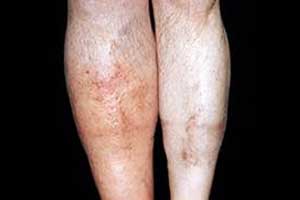- Home
- Editorial
- News
- Practice Guidelines
- Anesthesiology Guidelines
- Cancer Guidelines
- Cardiac Sciences Guidelines
- Critical Care Guidelines
- Dentistry Guidelines
- Dermatology Guidelines
- Diabetes and Endo Guidelines
- Diagnostics Guidelines
- ENT Guidelines
- Featured Practice Guidelines
- Gastroenterology Guidelines
- Geriatrics Guidelines
- Medicine Guidelines
- Nephrology Guidelines
- Neurosciences Guidelines
- Obs and Gynae Guidelines
- Ophthalmology Guidelines
- Orthopaedics Guidelines
- Paediatrics Guidelines
- Psychiatry Guidelines
- Pulmonology Guidelines
- Radiology Guidelines
- Surgery Guidelines
- Urology Guidelines
Ultrasound elastography may distinguish between acute and chronic DVT

Ultrasound elastography (UE) imaging appears to be a promising technique for distinguishing between acute and chronic deep vein thrombosis (DVT), according to a new study published in the Journal of Thrombosis and Haemostasis.
UE imaging is a novel sonographic technique that is commonly employed for relative quantification of tissue elasticity. Its applicability to venous thromboembolic events has not yet been fully established; in particular, it is unclear whether this technique may be useful in determining the age of DVT.
Nicola Mumoli, Department of Internal Medicine, Ospedale Civile Livorno, Viale Alfieri Livorno, Italy, and colleagues conducted the study to assess the role of UE in distinguishing acute from chronic DVT.
Also Read: New fast blood test for diagnosis of deep vein thrombosis
For the study, the authors analyzed consecutive patients with a first unprovoked acute and chronic (3 months old) DVT of the lower limbs. Patients with recurrent DVT or with a suspected recurrence were excluded. The mean elasticity index (EI) values of acute and chronic popliteal and femoral vein thrombosis were compared. The accuracy of the EI in distinguishing acute from chronic DVT was also assessed by measuring the sensitivity, specificity, positive and negative predictive values, and likelihood ratios.
One‐hundred and forty‐nine patients (mean age 63.9 years, standard deviation 13.6; 73 males) with acute and chronic DVT were included.
Also Read: GPs trained in compression ultrasonography accurately diagnose deep vein thrombosis
Key Findings:
- The mean EI of acute femoral DVT was higher than that of chronic femoral DVT (5.09 versus 2.46), and the mean EI of acute popliteal DVT was higher than that of chronic popliteal DVT (4.96 versus 2.48).
- An EI value of > 4 resulted in a sensitivity of 98.9% (95% confidence interval [CI] 93.3–99.9), a specificity of 99.1% (95% CI 94.8–99.9), a positive predictive value of 91.1% (95% CI 77.9–97.1), a negative predictive value of 98.6% (95% CI 91.3–99.9), a positive likelihood ratio of 13.23 (95% CI 93–653) and a negative likelihood ratio of 0.001 (95% CI 0.008–0.05) for acute DVT.
"UE appears to be a promising technique for distinguishing between acute and chronic DVT. Larger prospective studies are warranted to confirm our preliminary findings," concluded the authors.

Disclaimer: This site is primarily intended for healthcare professionals. Any content/information on this website does not replace the advice of medical and/or health professionals and should not be construed as medical/diagnostic advice/endorsement or prescription. Use of this site is subject to our terms of use, privacy policy, advertisement policy. © 2020 Minerva Medical Treatment Pvt Ltd